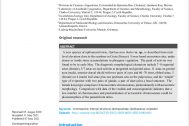Obsah
A new species of opilioacarid mite, Opilioacarus thaleri n. sp., is described from mid-level elevation close to the seashore in Crete (Greece). It was found on moister sites, under stones or inside stone accumulations in phrygana vegetation. The peak of activity was found to be in early May. The diagnostic morphological characters include 7–8 eugenital setae (female), 5/7 setae on each sclerite at pregenital and genital areas, 11 setae on genital area (male), anterior dorsal shield with two pairs of eyes and 60–70 stout, ribbed setae, 5 (female) or 6 (male) leaf setae plus one pectinate seta on the palp tarsus, and the “simple” type of ovipositor with two pairs of glands, a pair of ducts plus a basal structure. The female karyotype comprises 16 monocentric chromosomes, predominantly with acrocentric morphology. Comparison with data of the ixodids and mesostigmatids indicates that a low number of chromosomes and predomination of acrocentric chromosomes could be plesiomorphies of the parasitiform mites.



